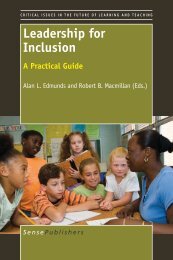1177-threshold-concepts-and-transformational-learning
1177-threshold-concepts-and-transformational-learning
1177-threshold-concepts-and-transformational-learning
- No tags were found...
Create successful ePaper yourself
Turn your PDF publications into a flip-book with our unique Google optimized e-Paper software.
LAND ET ALEun-Jung Park <strong>and</strong> Greg Light (Chapter 16) sought to identify a <strong>threshold</strong> conceptin studies at the atomic <strong>and</strong> molecular levels in the relatively new field ofnanoscience. Their study (after Davies, 2006) adopted both top-down (expertfocused)<strong>and</strong> bottom-up (student-focused) methods. These methods included ‘theconstruction of concept maps <strong>and</strong> an interview with the expert (professor), <strong>and</strong> theconstruction of pre- <strong>and</strong> post- course concept maps <strong>and</strong> the completion of a linkedopen-ended survey by the students’. Interestingly both methods tended to convergeon one particular potential <strong>threshold</strong> concept, surface area-to-volume ratio, asa c<strong>and</strong>idate for nanoscience, at least within this taught programme. Of this<strong>threshold</strong> concept the expert professor commented:Well, surface-to-volume ratio is the <strong>threshold</strong> concept, because you can’t getdown here (the nano level) without accepting the fact that really tiny particleshave large surface-to-volume ratio… So take a gram of something <strong>and</strong> keepchopping it up until you get down to nano-particles. And what you see is thesurface area just goes through the roof. So this is enabling... because, withoutthat, you can’t do this. So this would be a <strong>threshold</strong> concept.The professor also identified eleven key, or important, <strong>concepts</strong> within this field.The survey of forty-two student pre- <strong>and</strong> post-course concept maps revealed thirtyeightfurther <strong>concepts</strong>, in addition to the professor’s original eleven. The authorsemployed a phenomenographic approach to analyse the experiential component ofthese maps to identify variation in the ways students experienced the troublesomenessof the concept. This revealed ‘a hierarchical continuum of patterns ofunderst<strong>and</strong>ing, each more complex <strong>and</strong> inclusive of the preceding patterns’ whichproduced an outcome space comprising the following five patterns of student underst<strong>and</strong>ing:1. Isolated, 2. Unconnected, 3. Detached, 4. Limited, <strong>and</strong> 5. Integrated.The key aspect of variation characterising the most complex pattern (‘Integrated’),<strong>and</strong> the pattern most closely reflecting the expert’s pattern, was the recognition of thecentral role of surface area-to-volume ratio in the integration of the key nano domain<strong>concepts</strong>. Both expert <strong>and</strong> student responses reported this as an integrative concept,whilst two thirds of the students selecting this <strong>threshold</strong> concept also experienced achange of underst<strong>and</strong>ing during the course towards a more sophisticated pattern. Inconsequence the authors conclude that their study presents ‘preliminary evidence thata meaningful underst<strong>and</strong>ing of surface area-to-volume ratio critically contributes tostudents’ ability to integrate other key <strong>concepts</strong> in the nano-domain’.Interestingly, however, the concept surface area-to-volume ratio, thoughselected as a <strong>threshold</strong>, was not regarded as a particularly troublesome or difficultconcept to underst<strong>and</strong>. The authors suggest this might be owing to the fact that‘troublesomeness does not necessarily reside directly with the <strong>threshold</strong> conceptbut rather in the integration of the domain cluster of <strong>concepts</strong> within the student’sunderst<strong>and</strong>ing’.They also report that the representation of student underst<strong>and</strong>ing gained fromconcept maps, though useful, is not a sufficiently rich source of data in itself foranalysis <strong>and</strong> interpretation of student underst<strong>and</strong>ing, <strong>and</strong> their ongoing study willemploy subsequent use of interview data.xxvi




